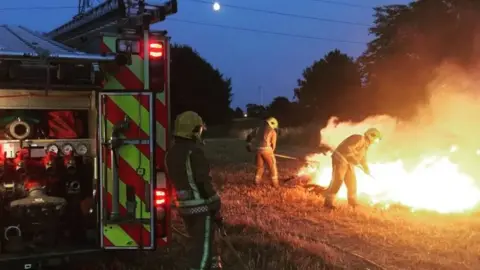'Bullying' issues found at Norfolk fire service
 Norfolk Fire and Rescue Service
Norfolk Fire and Rescue ServiceA culture of "bullying" has been highlighted at Norfolk's fire service in a government inspection report.
Norfolk Fire and Rescue was assessed for effectiveness, efficiency and how it manages staff.
The first government report in 10 years saw inspectors deciding the service required improvement in all categories.
Fire chief Stuart Ruff said he was "disappointed" with some of the findings, adding that bullying was "not acceptable and will not be tolerated".
Mr Ruff, who took up his post in April, said his top priority was to change culture among staff.
"I am committed to improving the service and acting on the points raised. I was saddened to learn that a number of staff felt there was an issue with bullying," he said.
Despite the overall rating, inspectors for Her Majesty's Inspectorate of Constabulary and Fire and Rescue Services (HMICFRS) found the service was "good" at responding to fires and national risks, looking after its finances and employing skilled people.
Post-Grenfell checks
But the report said it needed to carry out more preventative fire measures including home fire risk checks, especially in rural areas. At the moment its checks only amounted to half that of the national average.
In the wake of the deadly Grenfell Tower fire, it must also oversee audits of all of its 50 high-risk buildings, having only carried out 10 high-risk premises visits in 2018.
Of all the incidents it attended in the 12 months to September 2018, 33% were for fires, 34% for non-fire related matters and 32% for false alarms.
The cost of firefighters per person, in the year up to 31 March 2018, was £19.28 - less than the England average of £22.38.
Full-time firefighters accounted for 38% of the county's crew compared to 70% nationally, but it was found to make "good use of a variety of working patterns to match resources to risk".
Inspectors said they wanted to "see improvements in the year ahead".
